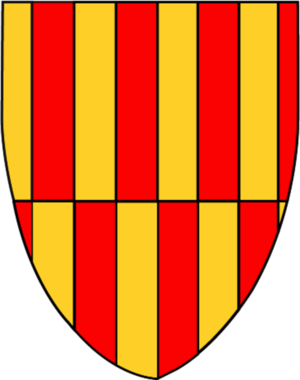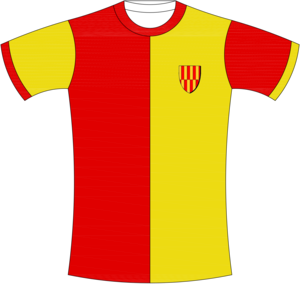The Kingdom of Northumbria
The Kingdom of Northumbria was one of a medieval Anglian kingdom founded in 7th century by merging of the Kingdoms of Bernicia and Deira. During the great part of its existence it had spread from the rivers Humber and Mersey in the south, and the river Forth in the north.

Coat of arms

Shirt
| Position | First name | Last name | Mjesto rođenja | Like | Dislike | |
|---|---|---|---|---|---|---|
| GK | Craig | GORDON | Edinburgh |
3 |
0 |
|
| GK | Fraser | FORSTER | Hexham |
4 |
1 |
|
| GK | Jordan | PICKFORD | Washington |
28 |
9 |
|
| DC | Gary | CAHILL | Dronfield |
8 |
3 |
|
| DC | Harry | MAGUIRE | Sheffield |
2 |
0 |
|
| DC | Michael | KEANE | Manchester |
5 |
2 |
|
| DC | Phil | JAGIELKA | Manchester |
2 |
0 |
|
| DRC | John | STONES | Barnsley |
19 |
1 |
|
| DR/MR | Kieran | TRIPPIER | Bury |
12 |
1 |
|
| DR/MR | Kyle | WALKER | Sheffield |
17 |
3 |
|
| DL | Aaron | CRESSWELL | Liverpool |
1 |
0 |
|
| DL | Danny | ROSE | Doncaster |
10 |
4 |
|
| DL | Leighton | BAINES | Kirkby |
3 |
0 |
|
| DRC/DMC | Phil | JONES | Preston |
7 |
1 |
|
| DMC | Danny | DRINKWATER | Manchester |
4 |
0 |
|
| DMC | Darren | FLETCHER | Dalkeith |
3 |
0 |
|
| DMC | Fabian | DELPH | Bradford |
1 |
0 |
|
| DMC | Jordan | HENDERSON | Sunderland |
23 |
6 |
|
| DMC | Michael | CARRICK | Wallsend |
2 |
0 |
|
| MC | Lewis | COOK | York |
0 |
0 |
|
| MC | Tom | DAVIES | Liverpool |
0 |
0 |
|
| MRLC/DL | James | MILNER | Leeds |
4 |
2 |
|
| AMC | Ross | BARKLEY | Liverpool |
6 |
3 |
|
| AMRL | Jesse | LINGARD | Warrington |
7 |
1 |
|
| SS/FC | Dominic | CALVER LEWIN | Sheffield |
2 |
0 |
|
| SS/FRLC | Wayne | ROONEY | Liverpool |
21 |
5 |
|
| FRLC | Danny | WELBECK | Manchester |
6 |
2 |
|
| FRLC | Jay | RODRIGUEZ | Burnley |
1 |
1 |
|
| FRLC | Jonathan | WALTERS | Birkenhead |
1 |
1 |
|
| FRLC | Marcus | RASHFORD | Manchester |
19 |
3 |
|
| FC | Andy | CARROLL | Gateshead |
0 |
1 |
|
| FC | Jamie | VARDY | Sheffield |
14 |
3 |
|
| FC | Jordan | RHODES | Oldham |
0 |
0 |
(Today part of: northern England, parts of southern Scotland)
Overall, the kingdoms on the Isle were not politically united (until the 10th century), and a permanent and efficient control over the great part of Britain showed itself to be out of reach for any of them, so it all came down to the dominion of one over the other at any given moment in history. The Kingdom of Northumbria reached its peak in the 7th century, when it was defeated by Mercia (768) and the Picts (685). As early as the 8th century, Northumbria had found itself facing raids by the Vikings, the pressure of which will be felt in the next century by all coastal regions, but it will not be until the 60s of the 9th century, when it was crushed by the so-called Great Danish Army (the sons of Ragnar Lothbrok), who pillaged nearly all of the central and eastern parts of the Isle, whilst Wessex was forced to pay tribute to them.
The language spoken in Northumbria differed from the language spoken in the Kingdoms of Mercia, Kent, and Wessex, and the overall speech of the eastern and northern areas of the Isle was under a strong influence of the Old Norse language, due to the Viking rule, and their settlements from the beginning of the 9th century. Nevertheless, because of their similarities, we can put them all in the category of the Old English language, which finds its roots in the cluster of Anglo-Frisian, or the North Sea Germanic dialects spoken by the Angles, Saxons, and Jutes during their conquest of the Isle, which brought with itself a suppression of the Romanic-Celtic tribes, who lived in these parts. Northumbria will formally keep its independence until the mid-10th century, but it will never again reach its former glory. Its northern borders (pushed south to the river Tweed) will serve as a foundation for geo-political relations of that which will much later become England and Scotland.
Sources
- Jeremy BLACK, Povijest Britanskih otoka, Zagreb, 2004,
- ''Kingdom of Northumbria'', https://en.wikipedia.org/wiki/Kingdom_of_Northumbria
- ''Old English'', https://en.wikipedia.org/wiki/Old_English
- GRB
- http://www.crwflags.com/fotw/flags/gb-nthum.html
